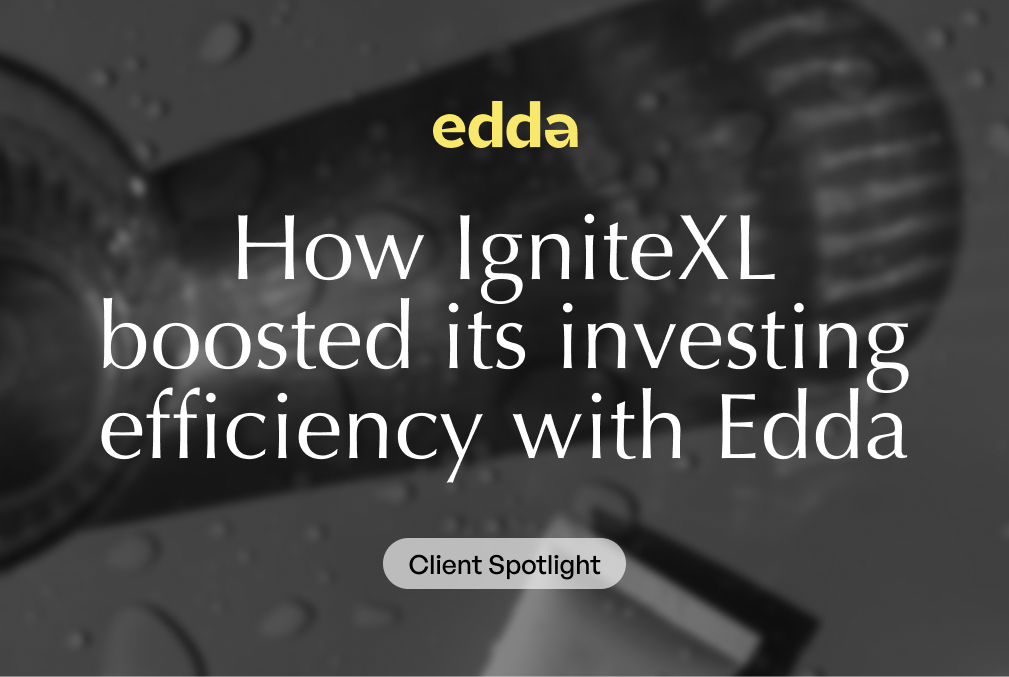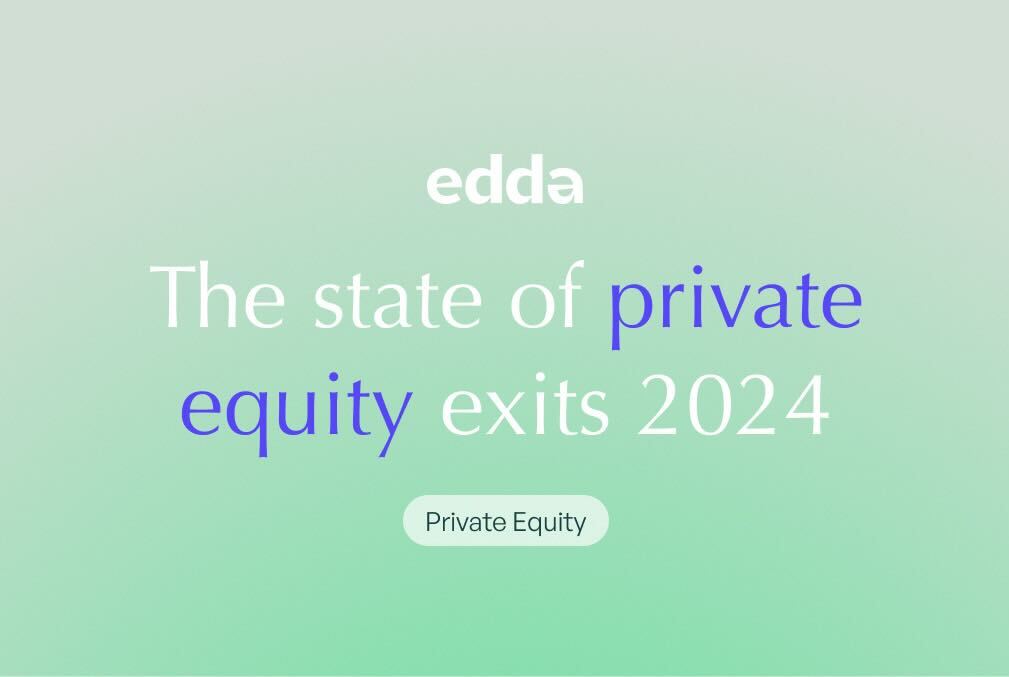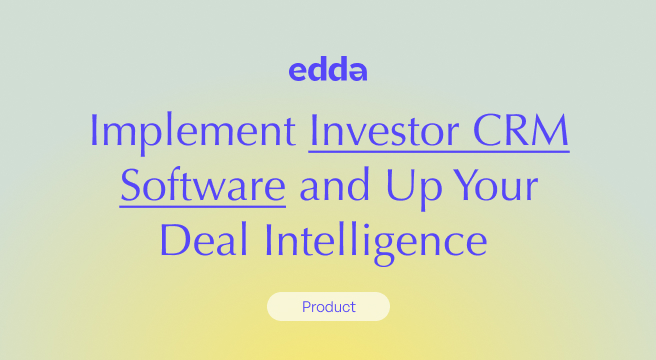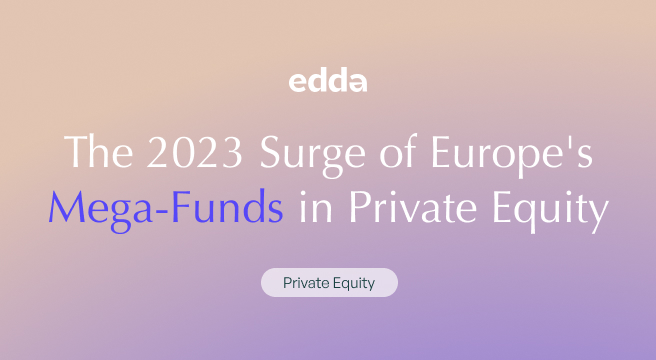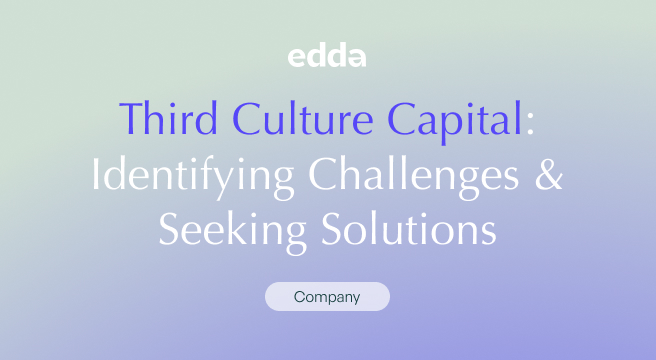In European private equity (PE) in 2023, the overall climate for fundraising faced challenges. However, a stark contrast emerged, characterized by the exceptional success of mega-funds—those with capital commitments of €1 billion or larger.
This article unpacks this anomaly, exploring the conditions that allowed European mega-funds to thrive despite broader market difficulties. By examining investor behavior, the strategic positioning of large funds, and the evolving dynamics of the investor base, this article provides stakeholders with a comprehensive understanding of the factors driving the success of mega-funds.
In addition, explore the cutting-edge capabilities of Edda’s CRM for venture capital and private equity.
Overview of European Mega-Funds
Mega-funds in European private equity are defined as investment vehicles that command a capital commitment of €1 billion or more. These funds stand out not just for their size but for their capacity to influence market trends and attract substantial investor interest.
In 2023, despite the overall downturn in fundraising, these funds secured record-breaking amounts, with notable closures such as CVC Capital Partners’ €26 billion buyout fund, which set a global record, and Permira’s eighth flagship fund reaching €16.7 billion. These figures underscore the significant role mega-funds play in the European private equity landscape.
The success of these mega-funds is indicative of their robust infrastructures and established networks, which allow them to execute large-scale transactions and deliver consistent returns. Such capabilities are crucial in a market environment fraught with economic uncertainties, where investors gravitate towards stability and proven track records. The substantial capital raised by these funds reflects their dominant market position and strategic importance in shaping the private equity sector in Europe.
Investor Behavior & Preferences
In 2023, the broader European private equity landscape was shaped significantly by investor behavior, particularly in the context of economic volatility. Investors showed a marked preference for allocating capital to established and larger private equity managers, often at the expense of smaller and less experienced general partners (GPs). This trend was driven by the perceived safety and lower risk associated with seasoned managers who have demonstrated the ability to navigate through various market cycles effectively.
Macroeconomic headwinds, such as inflationary pressures and geopolitical uncertainties, heightened the need for reliability and proven track records, which mega-funds typically embody. Limited Partners (LPs) reverted to these trusted entities, leading to fewer but larger fund closes. For instance, the five largest European PE funds in 2023 accounted for over half of the total capital raised in the region, illustrating a significant consolidation of trust and resources towards these mega-funds.
This shift in investor preference highlights a cautious approach to private equity investment during times of crisis, where the allure of large, stable funds becomes even more pronounced. The behavior of LPs during this period demonstrates a strategic retreat to safety, favoring funds that promise not just returns but also a high degree of security in capital deployment.
Diversification of Investor Base
In response, larger private equity (PE) firms in Europe have strategically broadened their fundraising approaches by targeting a more diverse investor base. This includes a significant focus on retail and private wealth investors, expanding beyond the traditional institutional investor circles. By tapping into high-net-worth individuals and family offices, these mega-funds are diversifying their sources of capital while mitigating the risks associated with over-reliance on a few large institutional backers.
The engagement with retail and private wealth sectors is facilitated by several factors. First, regulatory changes in many jurisdictions have gradually lowered barriers for private investors to participate in private equity.
Secondly, the increasing digitization of investment platforms allows easier access for these investors to previously exclusive markets. This democratization of investing in PE not only broadens the capital base for mega-funds but also injects fresh liquidity into the market, which is crucial during times when traditional funding sources may be more conservative in their investment activities.
Moreover, reaching out to a broader investor base helps PE firms stabilize their funding during economic downturns, as these new channels can provide a more steady influx of capital. The diversification strategy not only enhances the financial robustness of mega-funds but also enriches the ecosystem by involving a wider array of stakeholders in the value-creation process typical of private equity investments.
Comparison with the US Market
The dynamics of European mega-funds contrast notably with their counterparts in the United States, presenting an intriguing comparison in terms of growth potential and investment patterns. While Europe has seen significant capital consolidation within a few large funds, the U.S. market is characterized by a broader distribution of investment across a larger number of funds. This difference partly stems from the varying investor base composition and regulatory environments in the two regions.
In the United States, large institutional investors such as pension funds and endowments have traditionally allocated a significant portion of their portfolios to private equity. These institutions view private equity as a key component of their investment strategy, driven by long-term growth and high return potential. For example, many U.S. pension funds allocate upwards of 10% of their portfolios to private equity, a stark contrast to their European counterparts where such high allocations are less common.
Furthermore, Norway’s $1.6 trillion sovereign wealth fund is a case in point for Europe’s cautious approach; despite its vast resources, it has historically avoided private equity investments but is now reconsidering its stance. This shift could signify a broader change in European institutional attitudes towards private equity, potentially leading to greater parity with U.S. investment levels in the future.
The comparative analysis underscores that while European mega-funds continue to grow, they still have considerable room to expand, especially if European institutional investors increase their private equity allocations. As these investors begin to match the aggressive investment strategies seen in the U.S., European private equity could experience a significant transformation in its funding arena.
Growing Institutional Interest
The allure of European mega-funds has been increasingly recognized by institutional investors not only within Europe but also from North America. This growing interest is evident in several key developments and strategic investment decisions made in recent years.
Notably, in the United Kingdom, nine of the country’s largest defined contribution pension schemes committed last year to invest up to 5% of their default funds in unlisted equities by 2030. This move marks a significant shift towards embracing private equity, particularly in sectors that promise higher returns and are perceived as growth enhancers.
This rising interest is further supported by a broader reassessment of investment strategies among European institutional investors. Many are now seeking to diversify their investment portfolios and mitigate risks associated with traditional equity and bond markets.
The dynamic performance and the resilience shown by mega-funds during economic uncertainties have made them an attractive option. Additionally, North American Limited Partners (LPs) have also shown an increased propensity to invest in European PE funds, driven by the potential for high returns and a desire to diversify geographically.
As a result, European mega-funds are not just seen as temporary safe havens but as pivotal players in the long-term investment strategies of major institutional investors. This shift reflects the confidence in the management capabilities of these funds and the growing globalization of investment capital, which could reshape how European private equity is perceived and engaged on the global stage.
Challenges & Future Outlook
The European private equity (PE) landscape, particularly for mega-funds, is poised for significant shifts as the market adjusts to broader economic changes and evolving investor expectations. The fundraising climate for 2024 appears optimistic as interest rates are expected to decline, potentially easing some of the financial pressures and making PE investments more attractive. This could lead to a diversification in the types of funds that successfully raise capital, potentially reducing the dominance of mega-funds, though they will likely remain influential in the market.
However, several challenges persist that could shape the future trajectory of these funds. The lengthening time required to close funds, now reaching up to 18 months, highlights a cautious investor approach amidst global economic uncertainties. Furthermore, the increasing scrutiny on the performance and management fees of large funds could lead to more rigorous evaluation processes by LPs.
Despite these challenges, the foundational strength of established mega-funds, characterized by their large-scale operations and significant track records, positions them well to continue playing a major role in Europe’s PE market. They are likely to continue attracting substantial investments, particularly from institutional investors looking for stability and consistent returns.
Investors and fund managers must stay agile, adapting to the evolving economic indicators and investor sentiments to maintain competitiveness. Strategic adjustments in investment approaches, increased transparency with LPs, and enhanced alignment with investor interests will be crucial for sustaining success in the coming years.
Edda: The Best Private Equity CRM
As private equity evolves within mega-funds, adopting advanced tools like Edda’s CRM for PE and venture capital organizations becomes essential. Edda’s CRM offers sophisticated fund management capabilities, enhanced analytical tools, and improved investor relations functionalities, which are crucial for managing large-scale investments and complex investor networks characteristic of private equity mega-funds.
By integrating such advanced solutions, PE firms can better navigate the competitive market, maintain robust investor communications, and streamline fund operations, ensuring they remain at the forefront of the industry.
Ready to elevate your private equity fund management? Contact us today to learn how portfolio monitoring private equity tools can streamline your investment processes, enhance decision-making, and strengthen investor relationships for sustained success. Discover the transformative impact of our private equity CRM tools tailored specifically for large-scale private equity firms.

